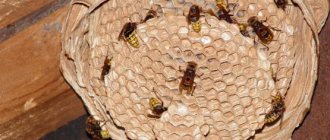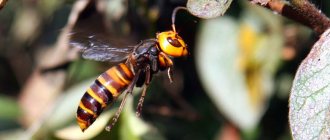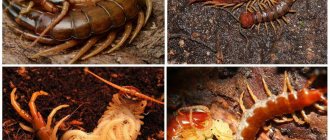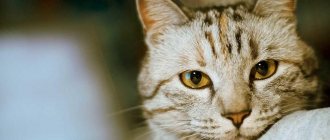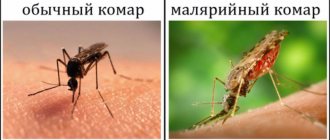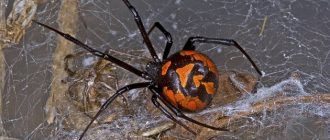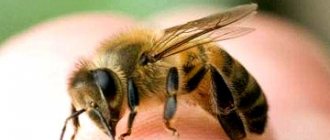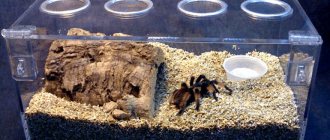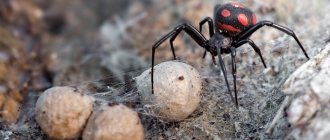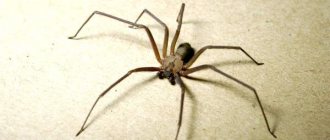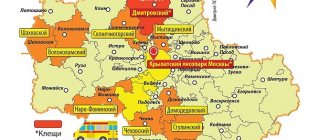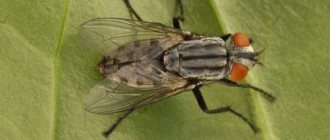The karakurt spider usually lives in regions with hot and dry climates. However, changes in weather conditions have led to the spread of the insect to areas located much north of its usual habitats. It is increasingly found in regions where it was previously impossible to see it. At the same time, the karakurt bite is dangerous for humans and domestic animals.
Let's consider where the poisonous spider lives, whether a karakurt bite is fatal, what symptoms appear, what measures include first aid and treatment, whether there will be consequences, how to deal with the insect at home and in the country.
Who is Karakurt
This is a poisonous spider belonging to the black widow family. In total, more than 30 species of the family are known, which are found on all continents of the planet, of which 8 live in Eurasia. All of them are dangerous to humans. The name of the genus, black widow, is explained by the fact that the female eats the male karakurt after mating.
The body of the spider has a black spherical shape. The coloring of different types of karakurt differs in shades of spots - from bright red in steppe representatives, to white-brown in European ones. A characteristic feature of spiders is the shape of their legs, which resemble a comb.
The population of karakurts in nature is regulated by their natural enemies - wasps and hedgehogs. Insects from the order of riders use the spider's cocoon for their own eggs, thereby destroying its offspring. Sheep and pigs trample their clutches as they move across the pasture.
The size of the karakurt depends on gender. The female can reach two centimeters, and the male does not exceed 1 cm, usually about 7 mm in length.
Karakurt bites the victim using chelicerae (jaws), and then injects the secretion of poisonous glands. Therefore, having examined the wound, you can see two small spots located nearby. Only female karakurts are dangerous to people. The male's small jaws prevent him from piercing human skin.
Appearance and structural features
Outwardly, this spider seems, if not cute, then at least not disgusting - it has neither hair nor fluff, like many of its relatives (for example, the tarantula). Nevertheless, the bite of the karakurt spider is extremely dangerous, and if a person is not given first aid, he may die.
This spider has a ball-like abdomen and cephalothorax. They are connected to each other by the seventh segment (like our vertebra) of the cephalothorax. Limbs diverge from the abdomen: four pairs of legs and two pairs of jaws.
The abdomen is a symbiosis of the telson (anal lobe) and eleven segments. The female has chelicerae (upper jaws) that end in hooks. And on the other side of the jaws there are poisonous glands. The female is the most dangerous.
On the back of the spider there are reddish-orange dots with a white rim. They can have any shape. It is by these that you can determine that a karakurt is watching you. Growing up, the spider (male) does not lose color - the dots remain. And the female changes noticeably: sometimes instead of spots she has yellow stripes on her abdomen.
Where in Russia does the karakurt live?
The spider is found in the Middle East, Africa, Central Asia, and Europe. In Russia, it mainly lives in the southern regions - in the Caucasus, Crimea, Azov region, and Black Sea region. It can be found in the Astrakhan, Rostov, Volgograd regions, Krasnodar Territory. Karakurt gives preference to steppe regions.
Usually the spider weaves its web near the ground on bushes. To reproduce, it builds a den in animal burrows and soil crevices, but can also crawl into various buildings and garden plots. The optimal conditions for it are sparse thickets along the banks of lakes and rivers, in ravines, and in wastelands. Karakurt can also be found near human settlements - in heaps of garbage, isolated bushes on the beach, in a ditch, near barns, in a crevice in a clay wall. The black widow usually lives in dark corners. Its masonry can even be found under the hood of a car. The web is located 30–50 cm from the ground and is distinguished by its asymmetry and increased strength.
In hot years, the range of karakurt expands. To reproduce, they migrate, carried by the wind on webs and seeking protected mating sites. During long periods of hot weather, karakurt can be found even in the Moscow region, Chelyabinsk, Orenburg, Saratov regions. And the habitats in the Novosibirsk region and Altai have become completely uncharacteristic for this species.
The reasons for the atypical settlement of karakurts are a long period of hot weather, as well as human importation of southern vegetables and fruits along with them. But usually the spiders then die in the cold winter conditions.
Spider Information
Karakurt (Latrodectus tredecimguttatus) has a more common name in everyday life - black widow. He received this nickname for the color of the females (there are 13 black dots on the bright red body, the rest of the parts are completely black), which are extremely poisonous.
Natural distribution area: Mediterranean and Black Sea coasts, steppes of Ukraine, Crimea, Caucasus, Central Asia, southern and middle regions of the Russian Federation. Spiders are up to 2 cm in size, males are three times smaller than females.
Most often, representatives of the genus can be found on the steppe plain, among stones, in grass, in mown fields, meadows, along the banks and on various slopes. Karakurts often live among wormwood.
The female makes a nest in empty holes or hollows, under stones and various shelters. You can notice it by the chaotic trapping web, which gathers in a denser lump (an example is shown in the photo). There is a dwelling in this place.
Karakurt - steppe widow (Latrodectus tredecimguttatus)
Most often, bites are recorded in hot weather. The number of females by this time becomes larger, they begin to migrate to establish new nesting sites.
The fertility of spiders is high; in some places there can be up to ten nests per square meter. Most often, karakurt attacks occur during agricultural work in the field or overnight in nature.
The invertebrate itself is quite delicate and can be easily injured or crushed, which is what usually happens. But if you press a female karakurt and she manages to hit the skin with her mandibles, then you should expect very unpleasant consequences.
The animal never attacks first. Bites most often occur due to human inattention when insects crawl into clothing. It is not uncommon to find a spider in haylofts, outbuildings and other premises in rural areas.
Note. Female karakurt pose a danger to humans and animals. Males are small and cannot bite through the skin.
Karakurt poison
It contains enzymes and a protein neurotoxin - alpha-latrotoxin, which is the main active ingredient. The poison selectively affects presynaptic nerve endings. The presence of a neurotransmitter is necessary for the transmission of a nerve impulse, but alpha-latrotoxin depletes its reserves at the synapses.
After a bite, the victim initially develops painful muscle contractions that spread throughout the body. In the future, with severe poisoning, karakurt poison causes paralysis, including the respiratory muscles. All changes occurring in the human body are united by the name - latrodectism.
Animals - rodents, horses, camels, cattle - also suffer from a karakurt bite. Dogs, hedgehogs, and reptiles react less to poison.
Kinds
There are several varieties of karakurt:
- Karakurt “thirteen points” - got its name from the number of red dots on the body. The most common type of black widow. Karakurt puppies are born almost transparent, but after the first molt they darken and light spots appear on the body. With each moult, the body color approaches black, and the color of the spots approaches red.
- Dahl's karakurt differs from ordinary karakurt only in appearance - it is completely black.
- White karakurt is a yellowish-white spider. There are no spots on the body except four dark spots on the back. The females of this species are the largest among the karakurts, but, of course, they are significantly inferior to other arachnids, for example, tarantulas. This steppe spider has a characteristic manner of movement - it seems to be dancing, flapping its paws. For this reason it is called the dancing spider.
- Fake karakurt. This spider is similar to the poisonous karakurt and belongs to the same genus as snake spiders. But it does not belong to the genus of black widows, but to the genus Steatoda and is called Steatoda Paikulla. The difference from a real karakurt is a red or yellow line running down the stomach.
Some karakurts are named after their place of distribution. So, for example, a Crimean lives on the territory of the Crimean Peninsula.
Why is karakurt dangerous?
The spider itself does not attack, it attacks only when defending itself. Poisoning caused by a bite does not become any less toxic. Females are more dangerous to humans.
A burning pain appears immediately, quickly spreading from the bite site throughout the body and localizing in the abdomen, lower back, and chest. Abdominal tension, priapism (painful erection), bronchospasm, and prolonged absence of the urge to defecate and urinate may appear. Then excitement gives way to depression, deterioration of consciousness, and delirium.
A karakurt bite can be fatal to children or the elderly.
The most dangerous periods are associated with the mating season - June, July, August. At this time, the female is looking for a place for a new nest. The threat of a collision with a poisonous spider increases during the seasons of active outdoor recreation and collection of plant materials. Summer is a time of intensive work in the garden, in gardens, on agricultural fields and lands. A karakurt bite can be caused by walking in thickets of grass, turning over stones, or working on making hay. A person's carelessness provokes an attack by a poisonous spider and severe poisoning.
Karakurt spider
Social structure and reproduction
Photo: Karakurt spider in the Rostov region
This type of arthropod is characterized by a high degree of fertility. Every 9-12 years there is an incredibly high birth rate of these dangerous insects. The mating season begins at the height of the summer season. Before the start of the breeding period, the female looks for a secluded place. The male lays out a web that contains special pheramones that attract individuals of the opposite sex. Seeing his partner appear, the male performs something similar to a dance. He sways from side to side, moves his limbs.
After mating, the female mercilessly eats her partner and begins to look for a suitable place to lay eggs. Once a place is chosen, she carefully weaves it with a web, on which she lays out the cocoons. After the mission is completed, the female dies. The cocoon reliably protects the eggs from damage and cold. If strong winds blow in the fall, they tear off the cocoons and can carry them far into the steppe, spreading the spiders’ habitat.
From the moment the eggs are laid, small insects appear after about two weeks. However, they are in no hurry to leave the cocoon, as they are waiting for the onset of spring and warming. During the first time they are in the cocoon, they exist due to the accumulated nutritional components. Subsequently, they begin to eat each other, as a result of which we can say with confidence that the strongest individuals emerge from the cocoon in the spring.
The growth and development of spiders continues throughout the spring and summer period. During this period, each individual goes through 5 to 10 molts. The exact amount depends on the amount of food and gender. Females shed more than males.
Interesting fact: The body of the spider is covered with a chitinous shell, which limits the growth and development of the arthropod. During the molting process, the karakurt sheds its shell, replacing it with a new one, larger than the old one in size.
Symptoms of a bite
Karakurt poison triggers a complex mechanism. The psychotropic effect is expressed by a change in the victim’s behavior. Neurotoxic effects affect muscle tone.
The clinical picture manifests itself in the process of absorption of the poison. The karakurt bite site turns red and becomes swollen. After 10–15 minutes, the first signs of poisoning appear:
- after a karakurt bite, severe pain spreads throughout the body, affecting the limbs, back, stomach, lower back, and chest;
- restless behavior, expressing fear of death;
- chills;
- thirst;
- visual hallucinations;
- excessive sweating;
- lacrimation;
- nausea, vomiting;
- increased body temperature;
- involuntary shaking (tremor) and muscle twitching;
- shortness of breath, bronchospasm, followed by paralysis of the respiratory muscles;
- an increase and then a decrease in blood pressure, heart rhythm disturbances;
- urinary retention.
A characteristic syndrome is a “latrodectic face,” distorted by pain and fear, drenched in sweat, with swollen, reddened eyelids.
The severity of poisoning depends on the initial condition of the victim. The risk group includes elderly and senile people, children, and patients with chronic diseases.
Is it possible to die from a karakurt bite? - Yes. In the absence of specialized medical care, acute cardiac and respiratory failure develops with circulatory arrest. The introduction of a specific antidote for a karakurt bite neutralizes the effect of the poison and reduces the consequences of poisoning.
Magazine "Child's Health" 3 (24) 2010
Severe intoxication from insect bites, requiring hospitalization, is not a common condition in pediatrics. At the same time, over the past decade, in the southern regions of Ukraine, including the Autonomous Republic of Crimea, cases of attacks on humans by poisonous arthropods have become more frequent, especially in the summer-autumn period. The expansion of the habitat of arthropods and the inevitable increase in their contacts with humans is facilitated by climate warming and hot and dry summer months. Despite the vivid symptom complex, the diagnosis of such poisoning is difficult in the absence of relevant medical history. Here is our own observation.
Child B., 5 years old, a resident of the Lugansk region, was on vacation in Crimea in August, in one of the steppe seaside resorts. He lived with his parents in a wooden boarding house adjacent to the fields. On the eve of the disease, all family members ate pilaf for dinner. He became acutely ill at night and woke up crying and complaining of sharp pains in his stomach. Until the morning he was restless, his temperature rose to 37 ° C, and pain appeared in his right ear. In the morning - single vomiting. At 6:30 a.m., due to previous complaints of ear pain and ongoing episodes of abdominal pain, the parents took the child to a multidisciplinary children's hospital. In the emergency department he was examined by an otolaryngologist (catarrhal otitis media was suspected) and a surgeon. After a cleansing enema, a single watery stool was obtained; during observation, the suspicion of an “acute abdomen” was not confirmed. An increase in body temperature to 37.5 ° C was detected.
With a “duty” diagnosis of “ARVI, right-sided otitis media.” Food poisoning?" sent to the children's infectious diseases hospital, where he was taken by his parents at 11.00. Upon admission, the parents complained of an increase in the boy’s body temperature to 37.7–37.9 °C, abdominal pain, pain in the right ear, sudden sweating, lethargy, muscle weakness, up to the inability to stand on his feet and sit steadily.
The general condition is assessed as serious. Lethargic, apathetic. The expression on the face is pained; the patient responds reluctantly (after repetition) or does not respond. There are no meningeal signs, focal symptoms, or stem disorders. Chaotic muscle twitching in all muscle groups, as with chills, constant moderate tonic tension of the chest and abdominal muscles. The skin of the face is covered with large (up to 1 cm in diameter) drops of sweat, which quickly reappear after wiping, it is hyperemic, the rest of the skin is pale and clean. Swelling of the lips, eyelids, and periorbital area is pronounced. Profuse sweating not only on the face, but also on the torso and limbs. There are no elements of rash or skin damage. Peripheral lymph nodes are not enlarged. Turgor and tissue elasticity are physiological. The respiratory rate is 34 per minute, the depth of respiratory excursions is somewhat limited due to muscle rigidity. Breathing over the lungs is harsh, wheezing is not heard. Percussion sound is pulmonary. Age boundaries of the heart. The heart sounds are sonorous, the rhythm is correct, no murmurs are heard. Heart rate - 128 per minute. The tongue is covered with a white coating. In the pharynx there is hyperemia of the arches, the mucous membranes are clean. The abdomen is involved in breathing, accessible to deep palpation, not tense, superficial palpation is moderately painful. The liver and spleen are not palpable. There has been no urination for the last 13 hours. Watery stool, once (after a cleansing enema).
With a diagnosis of food poisoning, convulsive syndrome, he was transferred to the intensive care unit, where the listed symptoms were accompanied by double vomiting mixed with hematin.
Examination, consultations. Consultation with a neurologist: level of consciousness - stunned. It depletes quickly. Hyperhidrosis is pronounced. Meningeal symptoms are negative. Cranial nerves - without visible pathology. Muscle tone is reduced. Convulsive readiness, muscle tension of the lower extremities. Muscle strength - 5 points. Abdominal reflexes are absent. Tendon reflexes, S = D, uniform. Performs coordination tests satisfactorily. Active movements in full. Gets tired quickly after routine physical activity. There are no pathological pyramidal signs. Urinary retention. Conclusion: at the time of examination, there are general cerebral symptoms, which can be regarded as the probable development of cerebral edema.
Consultation with an otolaryngologist: rhinitis, right-sided catarrhal otitis. Consultation with an ophthalmologist: the optic discs are pale pink, their boundaries are clear, the course of the vessels is not changed.
General blood test: Hb - 109 g/l, Ht - 0.31, CP - 0.9, Er. - 3.6 x 10 12 /l, tr. - 238,000, lake. - 6.3 x 10 9 /l, pal. - 18, seg. - 52, lymph. - 25, mon. - 5, ESR - 10 mm/h.
Leukocyte intoxication index - 2.9. Bacterioscopy of a blood smear with Gram stain: no microflora was detected.
General urine analysis: yellow, beat. weight. — 1014, acidic, acetone ++, leuc. — 2–4 in the p/zr, renal. epit. — 2–4 in p/zr, phosphates — a large amount. Blood glucose - 5.3 mmol/l. Serum potassium - 3.4 mmoll, chlorides - 94 mmol/l, calcium - 2.3 mmoll. Total protein - 58.5 g/l, albumin - 40 g/l. Urea - 6.9 mmol/l, creatinine - 0.06 µmol/l, bilirubin - 11 µmol/l, ALT - 0.7 mmol/l·h, AST - 0.91 mmol/l·h, thymol test - 1 unit Blood clotting time (according to Sukharev) is 2"40". Prothrombin index - 77%. Fibrinogen A - 3 g/l, recalcification time - 1"55". Coprocytogram: mucus +, leukocytes - 8-10 in visual field, soap - a small amount. Stool cultures on the intestinal group did not yield a threefold increase.
In the OAIT, from the moment of admission, massive infusion-detoxification, anti-inflammatory and decongestant therapy was carried out, including reamberin, rheosorbilact, xylate, polyionic and glucose-saline solutions, magnesium preparations, L-lysine escinate, mildronate, dexamethasone, etamsylate, in the first 36 hours - situational analgosedation. Respiratory and circulatory failure, as well as organ damage, did not develop.
Careful clarification of the medical history made it possible to establish the following: the disease developed dramatically on the last night before leaving home. 2 hours after his usual bedtime, at approximately 00.10, the boy suddenly woke up from pain that quickly spread from the neck and right behind-the-ear region to the occipital and parietal region, and complained of abdominal pain. During the first hour after waking up, he cried continuously, tossed about (“couldn’t find a place for himself”), and complained of short-term abdominal pain. Over the next 2 hours, the parents noted in the child’s behavior a chaotic alternation of episodes of apathy at different times (“passed out with his eyes open”), euphoria, deep sleep, interrupted by extreme excitement with non-localized motor activity. The child's speech became unintelligible, and gradually some words were replaced by indistinct sound combinations. Emotions of panic fear were constantly present. Around the end of the first hour after waking up, the child’s facial skin gradually became moist and hyperemic, increased moisture in the skin of the palms, forehead and neck was noted, then sweating from the body became profuse and remained so during the first day of illness.
Against this background, from about 20 minutes after waking up, parents note the appearance of chills in the child, tremors in the muscles of the shoulder girdle, gradually increasing tension in the abdominal and chest muscles (at the same time, “he wanted to breathe deeply but could not, he was afraid of this condition”), exhalation periodically seemed intermittent or grunting. Then, gradually, weakness of the muscles of the neck and limbs began (“his head was leaning in all directions, he had to support him, he couldn’t pull up the sheets, he didn’t want to sit”). Since the increase in weakness became obvious only after 3 o’clock in the morning and was accompanied by a decrease in episodes of excitement and drowsiness, the parents regarded this as the child’s fatigue and a natural desire to sleep. After 4 o'clock in the morning the boy slept, woke up for a few minutes, and was capricious. The rapid heartbeat, periodically intermittent breathing, and severe sweating from cold skin persisted (“they only changed the top sheet, so as not to wake up, every 20–30 minutes”).
Despite the fact that the child’s condition was confidently stabilized against the background of pathogenetic therapy, the combination of clinical symptoms of the disease looked very non-standard. The missing link in the anamnesis resolved all doubts: 8 hours after hospitalization, the parents brought to the hospital a large spider (up to 3.5 cm with limbs), which they found in the folds of the baby’s bed at the head of the bed and was subsequently identified by the SES as a young female of the poisonous karakurt Lathrodectus tredicigumattatus (Fig. 1).
After 3 days from the start of intensive therapy, the boy’s condition improved significantly, which made it possible to remove him from the ICU. Infusion therapy continued in limited volumes, and he additionally received L-carnitine and Neurovitan.
Excitability, hyperkinesis, hyperhidrosis, swelling and hyperemia of the face gradually disappeared after 3 days. Muscle tone returned to normal after 3 days. From the 3rd to the 5th day there was an unsteady ability to hold the head in an upright position; he tried to lie down. The tendency to delay bowel and bladder emptying persisted for 5 days, and diarrhea did not develop. At the time of discharge, some physical asthenia and mild fatigue without restrictions in the motor sphere remained. Premorbid psycho-emotional and intellectual levels were restored without defects by the 4th day of hospital stay.
He was discharged in satisfactory condition on the 7th day of hospitalization at the insistence of his parents (due to his departure).
Final diagnosis: Main: Bite of a poisonous arthropod (karakurt). Associated: Rhinitis. Right-sided catarrhal otitis.
Literary reference (summary data). Karakurt (Lathrodectus tredicigumattatus) is an arthropod insect, a poisonous spider. It usually lives in the steppe; in recent years, there have been numerous reports of attacks on people not only in rural areas, but also in the cities of the southern regions of Ukraine. Circumstances of poisoning: agricultural work or recreation in karakurt habitats, accidental contact with a spider in utility rooms.
Toxicodynamics. The poison is a cloudy liquid of an alkaline reaction. When heated above 60 ° C, the poison loses activity. At low temperatures from 0 to –30 ° C, the poison retains toxic properties for several months. Destroys when heated to 100 ° C, under the influence of alcohol, ether, chloroform, and with prolonged exposure to direct sunlight. The main active principle of the poison is the protein neurotoxin (a-latrotoxin) - a presynaptic toxin, the target of which is a protein receptor located in the presynaptic nerve ending. The “neurotoxin-receptor” complex forms a channel for Ca 2+ ions, the latter enter the nerve ending, triggering the process of release of neurotransmitters. The result is overstimulation of motor muscle neurons in the ganglia. Under the influence of the neurotoxin, a 1000-1500-fold increase in the release of the neurotransmitter is achieved, which leads after 30-50 minutes to the depletion of its reserves in the nerve ending and the development of a complete block of neuromuscular transmission.
Pathogenesis, clinic. The bite of a female karakurt causes a symptom complex called Latrodectism. Karakurt poison is toxalbumin with a lymphohematogenous distribution route and a pronounced neurotoxic effect. Poisoning occurs violently and acutely: excitation is caused, followed by ataxia, the development of clonic and tonic convulsions, followed by paresis, as well as profuse salivation and lacrimation. The poison also has a curare-like effect. The karakurt's jaws are weak, and the poison is sprayed into the surface layer of the skin. At the site of inoculation of the poison, a sharp spasm of blood vessels and temporary damage to sensitive nerve endings occurs, so local signs of poisoning are much less pronounced than with a bite from a scorpion or tarantula. Many victims, especially those bitten at night during sleep, do not associate their sudden illness with a poisonous insect bite and seek medical help due to the general manifestation of intoxication. A sharp pain occurs at the site of the bite, which quickly passes. But after 10–15 minutes, pain appears in the joints and muscles, very intense pain in the entire bitten limb, which subsequently affects the muscles of the body, chest (severe difficulty breathing!), and abdomen. The pain is so severe that doctors mistake it for an “acute abdomen.” The face, at first pale, gradually turns red and even acquires a somewhat cyanotic tint, and drops of cold sweat stream down the face. Within 1–2 hours, the poison reaches the vital centers of the brain, causing characteristic neuropsychic disorders: exceptional anxiety, fear of death (Pavor mortis - lat.), melancholy, speech disorders, amnesia. The myotropic effect of the poison affects both skeletal and smooth muscles. Tonic tension of the abdominal muscles is painful and, in combination with moderate leukocytosis and low-grade fever, often simulates an “acute abdomen”. Due to weakness, the patient cannot stand on his own feet; with outside support, he stands in a very characteristic position, bent over. The venom contains protease, which increases vascular permeability and promotes hemorrhages in internal organs. Painful sensations are accompanied by pronounced muscle tension and fasciculatory muscle twitching. The muscles of the face are the last to be involved: a sweaty face, distorted by a grimace of pain and fear, with manifestations of blepharoconjunctivitis and lacrimation is called latrodectic face (facies latrodectismica). Also observed: nausea, hyperesthesia, convulsions, profuse sweating. From the cardiovascular and respiratory systems the following are observed: arterial hypertension (toxogenic karakurt hypertension), tachycardia, bronchorrhea, difficulty breathing. Damage to smooth muscles manifests itself in persistent spasm of the sphincters of the bladder and rectum to such an extent that the acts of defecation and urination become impossible. Other symptoms include vomiting, priapism, urinary retention, thirst, salivation, transient speech disturbances and, very rarely, roseola measles-like rash and itching. In extremely severe cases, excitement is replaced by apathy, depression, confusion (sometimes with psychotic reactions), collapse and progressive shortness of breath with symptoms of pulmonary edema (crepitus and moist rales, foamy sputum). A characteristic feature of intoxication with karakurt poison is not a dynamic alternation, but a layering of many symptoms. The full picture of severe acute poisoning usually lasts up to 48 hours, but in severe cases - much longer, up to several weeks (probably with a large dose of injected poison), gradual regression of symptoms occurs on average in 7-10 days. Sometimes after a few months there may be a recurrence of weakness, dizziness, and sweating, which go away without treatment.
Specific treatment is antikarakurt serum.
Apparently, the injured boy had a manifest picture of poisoning with karakurt toxin. It is possible that extreme severity with damage to internal organs did not develop even 10 hours from the beginning (by the time of hospitalization in the hospital) due to the not very large dose of poison (small age and size of the insect).
What in the described observation was the reason for the erroneous diagnosis of food poisoning and the referral of the child to the infectious diseases hospital?
The following signs testified in favor of food toxicoinfection: - epidemiological history - all family members ate pilaf in a roadside cafe in the summer; - short incubation period - the child fell ill a few hours after eating the food product; - clinical manifestations of gastroenteritis - one-time vomiting, watery stools; - temperature increase.
The following symptoms testified against acute intestinal infection: - absence of signs of disease in other family members who consumed the same food product; - hyperacute dramatic onset of the disease, lightning-fast dynamics and mosaic symptoms in the first 4 hours; - a clear predominance of neurotoxicity - psychoneurological and autonomic symptoms with a complete absence of organ damage in the future; - profuse sweat; - swelling of the lips and eyelids; - facial hyperemia, fear, pained expression; - sharp and constant pain in the muscles of the abdomen and limbs, combined with decreased tone; - muscle weakness (could not stand on his feet) in combination with muscle twitching and muscle tension in the limbs in the absence of hyperthermia or dehydration; - the appearance of loose stools after an enema (which is natural).
The objective reasons for the difficulty in diagnosis were in combination: - the rarity of contact between karakurt and children in our area (there are no observations in the Autonomous Republic of Crimea); — lack of toxicological statistics in our area; — extremely atypical circumstances (a poisonous insect crawling into a child’s bed in a resort area); — insufficient personal toxicological experience of doctors (due to the rarity of cases); - insufficiently detailed collection of anamnesis of the first hours of illness; — lack of “toxicological alertness” among doctors; - absence of obvious signs of an insect bite on the skin.
The consequence of the above was the establishment of a correct diagnosis “without exaggeration” only after a poisonous spider appeared in the field of view of medical workers.
conclusions
1. When observing atypical clinical manifestations in the warm season, it is necessary to carefully collect anamnesis from the child’s parents, taking into account the possibility of acute intoxication.
2. Constant “toxicological alertness” is required for doctors of all specialties, including surgical specialists.
3. Modern and timely initiated pathogenetic therapy, even in the absence of specific antitoxin serum, is able to prevent an unfavorable outcome from such intoxication.
First aid for a karakurt bite
An antikarakurt serum has been developed and successfully used. Its components inactivate the poison that is absorbed into the blood. The sooner the victim gets to the hospital, where he is given an antidote, the better the prognosis of the disease.
What to do if you are bitten by a karakurt? Local signs will appear weakly. Therefore, a rapidly deteriorating general condition should be alarming. If a bite occurs, then first of all you need to do the following:
- call the ambulance service;
- put cold on the bite site;
- until medical specialists arrive, immobilize the affected part of the body if possible;
- After the ambulance arrives, inform the doctors about a suspected karakurt bite.
What else can you do? There is one folk remedy - in the first minutes after a karakurt attack, cauterize the bite site with the flame of igniting 2-3 matches connected together. It is believed that since the spider’s venom is of a protein nature, the high temperature will cause the protein to coagulate and become inactivated.
In any case, it is necessary to seek medical help, as a terminal condition may develop caused by damage to the nervous system and difficulty breathing. It is life-threatening and requires cardiopulmonary resuscitation.
Treatment
Medical care begins with the administration of a specific antidote to karakurt toxin - anti-karakurt serum.
Main areas of intensive care:
- adequate analgesia;
- glucocorticosteroids;
- sedatives to relieve emotional stress;
- antihistamines (antiallergic) drugs;
- infusion (intravenous drip) of saline solutions to adjust the activity of the cardiovascular system;
- restoration of neuromuscular transmission;
- breathing correction - humidified oxygen, artificial ventilation;
- relief of bronchospasm symptoms;
- restoration of urination;
- symptomatic therapy - pain-relieving eye drops, normalization of body temperature.
In the international classification of diseases ICD-10, a karakurt bite has the code X21 - “Contact with a black widow spider.”
Consequences
Positive dynamics in the condition of the victim after a karakurt bite occurs slowly. The first signs of improvement appear only after 3–5 days. If the outcome is favorable, complete recovery may occur in 2–3 weeks.
Complications of a karakurt bite:
- weakness, fatigue;
- pain in the heart, limbs, lower back;
- dizziness;
- dyspnea;
- rapid heartbeat;
- sleep disturbances, falling asleep;
- loss of appetite;
- skin rash;
- hearing loss.
The consequences depend on the initial condition of the victim. Poisoning often causes exacerbation of chronic diseases.
Prevention
To prevent a karakurt bite, measures to prevent contact with the spider are necessary:
- maintaining cleanliness in the house;
- use of deterrents;
- application of insecticides;
- observing precautionary measures in nature during tourist outings, on the beach, and agricultural work.
Spiders feed on insects, so the extermination of moths and flies will leave the karakurt without food. Keeping the attic and roof in order and ventilating them will deprive spiders of their favorite habitats.
Experienced gardeners believe that too bright outdoor lighting at home attracts insects, and then spiders. Therefore, it is better to use “warm” LED lamps, to which midges react less.
Canopies will come in handy when traveling. When going outdoors, you must wear closed shoes and tight trousers. Avoid walking on rocky slopes at night. You have to carefully lift the stones. It is safe to carry out agricultural work wearing protective clothing. Gloves should be used when collecting medicinal plants. There is no need to leave your shoes outside or walk around the yard and garden barefoot. It is necessary to carefully inspect and shake off clothes after work. These precautions will help you avoid being bitten.
How to protect yourself from a spider bite
To avoid being bitten, you must first take precautions. When traveling to an unfamiliar area or a remote region, it is worth knowing in advance about the danger of poisonous arachnids. When going into nature, you need to carefully step on the branches so as not to disturb the inhabitants of the forest. Shoes must have high tops and be rubberized; trousers and a long-sleeved shirt made of thick material are required.
When hiking, you should not collect firewood without gloves. It is also necessary to close the tent tightly and carefully check before going to bed to see if anyone has crawled inside. It is better to stop for the night in cultivated places where human traces are visible. When you encounter a spider, you should not try to catch or tease it - in any case, you should quietly retreat to avoid unpleasant consequences.
